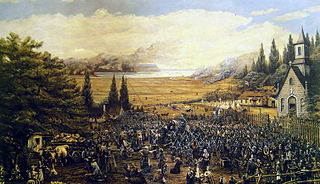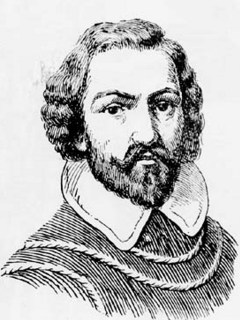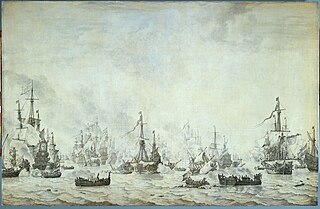Related Research Articles

1755 (MDCCLV) was a common year starting on Wednesday of the Gregorian calendar and a common year starting on Sunday of the Julian calendar, the 1755th year of the Common Era (CE) and Anno Domini (AD) designations, the 755th year of the 2nd millennium, the 55th year of the 18th century, and the 6th year of the 1750s decade. As of the start of 1755, the Gregorian calendar was 11 days ahead of the Julian calendar, which remained in localized use until 1923.

Juan Rodríguez Cabrillo was an Iberian maritime explorer best known for investigations of the West Coast of North America, undertaken on behalf of the Spanish Empire. He was the first European to explore present-day California, navigating along the coast of California in 1542–1543 on his voyage from New Spain.

Antonio de Ulloa was a Spanish naval officer, scientist, and administrator. At the age of nineteen, he joined the French Geodesic Mission to what is now the country of Ecuador. That mission took more than eight years to complete its work, during which time Ulloa made many astronomical, natural, and social observations in South America. The reports of Ulloa's findings earned him an international reputation as a leading savant. Those reports include the first published observations of the metal platinum, later identified as a new chemical element. Ulloa was elected as a Fellow of the Royal Society of London in 1746, and as a foreign member of the Royal Swedish Academy of Sciences in 1751.
This article is a list of the literary events and publications in the 15th century.

The Congrès Internationaux d'Architecture Moderne (CIAM), or International Congresses of Modern Architecture, was an organization founded in 1928 and disbanded in 1959, responsible for a series of events and congresses arranged across Europe by the most prominent architects of the time, with the objective of spreading the principles of the Modern Movement focusing in all the main domains of architecture.

The Battle of the Downs took place on 21 October 1639, during the Eighty Years' War. A Spanish fleet, commanded by Admiral Antonio de Oquendo, was decisively defeated by a Dutch force under Lieutenant-Admiral Maarten Tromp. Victory ended Spanish efforts to re-assert naval control over the English Channel and confirmed Dutch dominance of the sea lanes, while it is also alleged to be the first major action to feature line of battle tactics.

Juan de la Cosa was a Castilian navigator and cartographer, known for designing the earliest European world map which incorporated the territories of the Americas discovered in the 15th century. De la Cosa was the owner and master of the Santa María, and thus played an important role in the first and second voyage of Christopher Columbus to the West Indies.

Hasekura Rokuemon Tsunenaga was a kirishitan Japanese samurai and retainer of Date Masamune, the daimyō of Sendai. He was of Japanese imperial descent with ancestral ties to Emperor Kanmu. Other names include Philip Francis Faxicura, Felipe Francisco Faxicura, and Philippus Franciscus Faxecura Rocuyemon in period European sources, as he took a baptismal name upon converting to Catholicism.

Federico Laredo Brú was an attorney and served as President of Cuba from 1936 to 1940. He was married to Leonor Gomez-Montes. Laredo Bru was a Colonel in the Cuban Liberation Army during the Cuban War of Independence.

The Republic of the Rio Grande was one of a series of political movements in Mexico which sought to become independent from the unitary government dominated by Antonio López de Santa Anna; the Republic of Texas and the second Republic of Yucatán were created by political movements that pursued the same goal. Insurgents fighting against the Centralist Republic of Mexico sought to establish the Republic of the Rio Grande as an independent nation in Northern Mexico. The rebellion lasted from 17 January to 6 November 1840.
The year 1500 AD in science and technology included many events, some of which are listed here.
Jacinto Caamaño Moraleja was the leader of the last great Spanish exploration of Alaska and the coast of what is now British Columbia. He was a Knight of the Military Order of Calatrava.
Samuel Pallache was a Jewish Moroccan merchant, diplomat, and pirate of the Pallache family, who, as envoy, concluded a treaty with the Dutch Republic in 1608. His antecedents fled to Morocco during the Reconquista. Appointed as an agent under the Saadi Sultan Zidan Abu Maali, Pallache traveled to the newly-independent Dutch Republic to discuss diplomatic terms with the Dutch against their mutual enemy, the Spanish. He died in the Netherlands, brought there due to the intervention of his ally, Maurice of Nassau, who helped him when he was arrested by the Spanish.

During the Age of Discovery, the Spanish Empire undertook several expeditions to the Pacific Northwest of North America. Spanish claims to the region date to the papal bull of 1493, and the Treaty of Tordesillas signed in 1494. In 1513, this claim was reinforced by Spanish explorer Vasco Núñez de Balboa, the first European to sight the Pacific Ocean, when he claimed all lands adjoining this ocean for the Spanish Crown. Spain only started to colonize the claimed territory north of present-day Mexico in the 18th century, when it settled the northern coast of Las Californias.

The Magellan expedition, sometimes termed the Magellan–Elcano expedition, was a 16th-century Spanish expedition planned and led by Portuguese explorer Ferdinand Magellan. One of the most important voyages in the Age of Discovery—and in the history of exploration—its purpose was to cross the Atlantic and Pacific Oceans to open a trade route with the Moluccas, or Spice Islands, in present-day Indonesia. The expedition departed Spain in 1519 and returned there in 1522 led by Spanish navigator Juan Sebastián Elcano, who crossed the Indian Ocean after Magellan's death in the Philippines. Totaling 60,440 km, or 37,560 mi, the nearly three-year voyage achieved the first circumnavigation of Earth in history. It also revealed the vast scale of the Pacific Ocean and proved that ships could sail around the world on a western sea route.
Los Negros was a criminal organization that was once the armed wing of the Sinaloa Cartel and after a switch of alliances, became the armed wing of the Sinaloa splinter gang, the Beltrán-Leyva Cartel. In 2010 it went independent and had been contesting the control of the Beltrán-Leyva Cartel. It was then the criminal paramilitary unit of Édgar Valdez Villarreal in Mexico. Valdez was arrested on August 30, 2010, near Mexico City. Los Negros was led by Valdez at the time they merged with the Sinaloa Cartel.
Juan Carrasco was a Spanish naval officer, explorer, and navigator. He is remembered mainly for his work in the Pacific Northwest during the late 18th century. He was second in command of the 1791 voyage of José María Narváez, the first European exploration of the Strait of Georgia.
Pieter Schouten was a 17th-century Dutch corsair and privateer. He was one of the first Dutchmen to explore to the Caribbean and, while employed by the Dutch West Indies Company, was involved in extensive reconnaissance to establish Dutch bases in the West Indies.

Laredo Kid is a Mexican luchador enmascarado, or masked professional wrestler. He is currently signed to both Total Nonstop Action Wrestling (TNA) and Lucha Libre AAA Worldwide. In TNA, he is a former TNA Digital Media Champion.
The Battle of Muros Bay took place on 25 July 1543, during the Italian War of 1542–1546, between the French fleet under Jean de Clamorgan, Lord of Soane and the Spanish fleet commanded by Álvaro de Bazán, 1st Marquis of Viso. This battle is considered to be the first large naval battle in the Atlantic Ocean.
References
- ↑ Winfree, Arthur T. (2001). The Geometry of Biological Time (2nd ed.). New York: Springer. p. 10. ISBN 978-1-4757-3484-3.
- ↑ Fidèle de Ros (1948). "Chapter 2 : Le Médecin". Un inspirateur de Sainte-Thérèse. Le Frère Bernardin de Laredo (in French). Paris: Librairie philosophique J. Vrin.